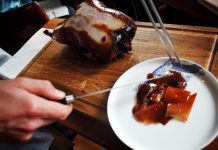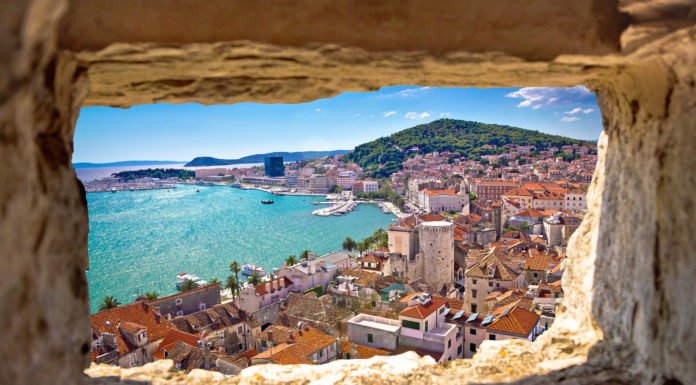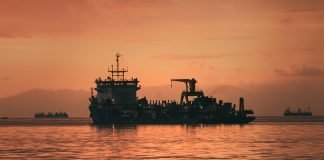To experience a different side of Bangkok, hop on a river taxi and sail through its ancient Siamese wonders.
From a distance, the pavements shone like fresh galvanized iron sheets straight out from the nearby factory. Last night’s tropical rain shower made them appear even brighter as I strut cautiously along the wet concrete that winds down to the river port.
As the hostile sun started to burn through the clouds and beat on my sunburned neck, the boat that would take me to the Royal Grand Palace was already cramped with early morning commuters. It was only eight A.M. in the “Land of Smiles” – Thailand.
I was warned not to take a taxi. Daytime traffic is tricky and can only get worse all throughout the evening.
“The best and only way to go around old Bangkok is by boat,” said the woman from the concierge while unfurling a map in front of me. Her fingers gyrated as she pointed out landmarks, prescribed stops along the way and carefully directed my attention to the little sois that will take me back to the hotel. The possibility of hiring the cute “tuk-tuk” driver whom I met the night before while looking for a couturier in the area didn’t escape my thought. I decided to stick to what I have been told.
Together with other commuters, we swarmed the russet-brown water on longtail ferry boats skimming the city’s biggest waterway. The Chao Phraya river snakes on a 219 mile-long stretch and meanders through its quieter klongs where hyacinths and lilies bob on the surface of the water. Every twist and turn brings the modern traveler closer to the city’s historical contours of each riverside neighborhood.
Bangkok’s Chao Phraya is a story in itself. A surging, restless living character whose past is intricately intertwined with the city it flows through. In May 1950, a coup d’état took place here where the Prime Minister at the time was taken at gunpoint. After being held hostage overnight inside a warship that was anchored in the middle of this great river, the Prime Minister hastily swam ashore after his release, just in time the air force obliterated the ship.
King Rama I once described it – the lifeblood of Thailand. The river feeds the broad Central Plains, creating the fertile rice bowl of the Kingdom and remains a crucial gateway to the outside world.
These days, more than 50,000 people use the river for transport. From slender high-speed boat taxis with their colorful flags to luxury private cruise as well as behemoth barges hauling cargos heading to the Gulf of Siam.
To the daily commuters, river taxis are a practical way of getting around, avoiding toll delays and the city’s congested traffic. To most visitors, the ride promises a sensory journey with views of gilded palaces, quirky markets and wooden bungalows teetering on the water’s edge.
From time to time, one catches a glimpse of intermingling faiths. Chinese shrines stand close to mosque minarets, Buddhist and Hindu temples nestling on one side and Christian churches modeled in Portuguese style on the opposite bank. There are temples dedicated to Buddha and its many forms or Tathagathas – the emerald in Wat Phra Kaew and the golden in Wat Arun. Aside from the usual enlightened pose, there’s also the famous reclining Buddha in Wat Pho. Perhaps the most unusual sight to behold is at Tuptim, a phallic shrine that brings protection and good fortune to those who visit.
Upstream, water lizards seek shelter under a Banyan tree while cats patrol the roofs of shophouses that may have belonged to an Indian, Chinese or Middle Eastern family who have found a home here since the 19th century. So Heng Tai Mansion is one of the oldest private residences in the city preserved in Hokkien-style fashion.
Over the years, a number of forgotten riverside neighborhoods have gone into gentrification. A handful of new event spaces and art galleries have opened together with trendy restaurants and cafes attracting younger local crowds and foreign tourists to rediscover the enduring old-world and new-fangled charm.
Among the old and the newly built, the Author’s Wing at the Mandarin Oriental Hotel is a place of riparian respite for the high-heeled and traveling scribes. Somerset Maugham and Noel Coward frequented the place. Joseph Conrad and Graham Greene once sojourned in one of the 40 commodious rooms overlooking the evocative river. In their eyes, Bangkok was the Venice of the East.
Cruising along the Chao Phraya river, one sees a different side of the city. By the river and aboard a boat, Bangkok’s way of life drifts past like the fleeting expressions of the people who come on board. Their worry lines and infectious smiles are almost familiar. Their gaze catches yours and in an instant, there’s an indescribable sense of knowingness and complicity. You start to relax and warm up to what the Thais called sabai sabai. Along its banks, communities flourish and dream, a world away from the daily grind of the buzzing capital. Memories are left in the water’s wake as new ones are formed by rising waves.
I held the map the woman from the concierge gave me that morning and ran my hands on the wrinkled pages. Feeling pleased to have followed her wisdom, I folded it neatly and placed it back inside my knapsack.
It was almost midnight when I got back to where I started my peregrination. Colorful strobe lights from the buildings cast their reflection on the waters, the city’s silent witness to the tides of change. The pavements no longer shine like blazing silvery sheets as they had done that morning. Seeing me alighting from the boat, the cute driver revved up the engine of his “tuk-tuk” and from a distance, I heard the chanting of monks, as if to wish me a safe and sweet journey ahead.
WHEN TO GO:
Located just 14 degrees north of the Equator, Bangkok is one of the hottest cities in the world. Although it is sunny at any time of the year with temperatures mostly over 30°C (86°F) that could reach to 40’s °C (around 100°F), the best time to explore the city is during the cool season that starts from November until February. Temple-tramping is fun yet tricky; a good bottle of water should always come handy.
MUST SEE & DO ALONG THE RIVER:
By boat, start the river artery from the Grand Palace (Chakri Maha Prasat Hall). Head off to Wat Pho (Reclining Buddha Temple) and then cross the river to Wat Arun (Temple of Dawn). Pass by the Memorial Bridge and make a stop at either the Indian Market or Chinatown. Light some incense at Wat Traimit (The Golden Buddha), make a short detour to the Wang Lee House and conclude the river cruise with afternoon Tiffin at the Mandarin Oriental Hotel.





















I’ve read many blog posts on Bangkok but never came across any of the travellers to do the boat trip. Thanks for taking me down the water ways and see the city now from another perspectives. I can see this to be a way to find some sort of quietness in a city that is full of buzz and chaos. In parts your pictures have reminded me of the river tour in Brisbane, shows how Bangkok is influenced by western cities, too
Carolin | Solo Travel Story
I still have a huge gap when it comes to South East Asia. Whenever I read articles about Bangkok, I think I really have to book a trip and go see it.
I’m sure that on my next visit I won’t be able to do without a stroll along the river, to get a better sense of the city’s surroundings and experiences.
I dont think I realized that there were water taxis in Bangkok. That would be a great way to get a new perspective of the city, as well as get around like you said. There seems to be a lot to do along the river – the temples are beautiful!
Lovely to read this as it brought back fond memories of one my first long distance trips I did abroad in my youth.
Bangkok was very different in those days- few skyscrapers but the traffic was still as bad.
I took the boats across the river a few times and once took an extended river trip up for about 20kn. The cooling breeze from the boats movement was a welcome relief from the hot sun.
What a delightful view of Bangkok. I have yet to get to Thailand but this post has me intrigued. Getting around on river boats would be sensible and provide a great way to see how the locals really move through their days. I really enjoyed seeing the juxtaposition of the modern city with the wooden homes in your photos and know I would love to see it in person. *sigh* my list of future destinations continues to grow
Lyn | http://www.ramblynjazz.com
Bangkok can be such an overwhelming city, and more than once I’ve gotten caught up in the chaos and just needed a time out. For me that was on the river. Sure, the river taxi can be busy, but it can also be a reprieve, something different, and a wonderful view of the city along the Chao Phraya. I once did a day trip on the boat organized by one of the river taxi companies, not sure if they still do it. But it sailed up out of Bangkok center and I got to explore some further away areas including some different temples and sites. Now I need to go back to Thailand after reminiscing about it
Loved this post which brought back memories of our all-too-brief sojourn to Bangkok. Like you, we did travel by river (and we recall that the traffic was truly awful) and it was by far the most delightful as well as practical way to see the sights of this vibrant city. King Rama’s assessment was right – the Chao Phraya really does feel like the lifeblood of Thailand. And I had no idea that so many revered authors had been regular visitors to the Mandarin Oriental.
Mitch from Very Tasty World